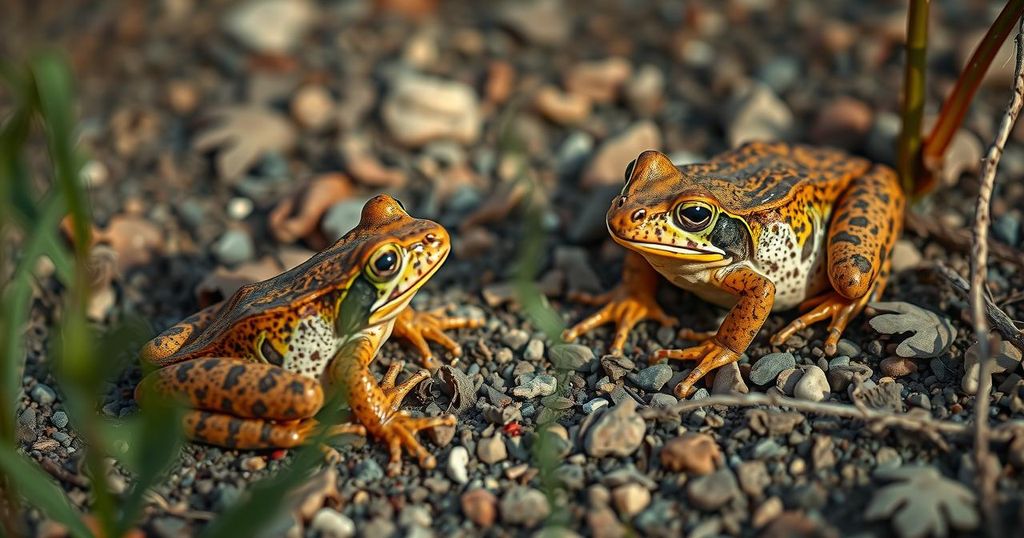Climate Change Threatens Frog Populations with Severe Drought and Habitat Loss

Research indicates that climate change may lead to severe water stress for frogs, with up to 33.6% of their habitats facing arid conditions by 2100. The 2023 Global Amphibian Assessment highlights that 41% of amphibian species are at extinction risk, exacerbating their vulnerability to drought and rising temperatures, which collectively threaten their physiological functions and habitats.
Recent research indicates that amphibians, specifically frogs and toads, are at risk of significant habitat loss and water stress due to climate change. A study published in the journal Nature forecasted that by the years 2080 to 2100, as much as 33.6 percent of anuran habitats could become arid under various climate scenarios. This research considered two potential futures: an intermediate warming scenario, raising temperatures by 2 degrees Celsius above pre-industrial levels, and a more severe high-emission scenario with a projected increase of 4 degrees Celsius. The 2023 Second Global Amphibian Assessment, part of the International Union for Conservation of Nature’s Red List, has categorized nearly 41 percent of amphibian species as being at risk of extinction, sealing their status as the most endangered class of vertebrates. The authors of this study caution that the increasing aridity of habitats is anticipated to double the water loss rates among these species, negatively impacting their movement, reproductive capabilities, and increasing their susceptibility to diseases. The study meticulously assessed how both drought and temperature increases would influence the physiological functions and survival of frogs. In the intermediate warming scenario, around 6.6 percent of currently inhabited areas by anurans could become arid by the end of this century, while in the high-emission scenario, this figure could rise to 33.6 percent. Between 2080 and 2100, an estimated 15.4 percent of environments where frogs currently reside are expected to encounter more severe, frequent, and lengthy droughts. Regions projected to be most impacted include the Americas, southern Africa, Europe, and southern Australia, with the Amazon and Atlantic forests facing the gravest challenges. The research also explored water retention strategies among different frog types, employing biophysical simulations. The data illustrated a decline in frog activity across the tropical biome when subjected to both warming and drought conditions, highlighting a decrease of 3.4 percent due solely to warming, 21.7 percent from drought alone, and a marked 26 percent decrease when both factors were combined. Such intensified drought and warming conditions significantly hinder the frogs’ thermal tolerance and appropriate body temperatures while exacerbating dehydration issues, which in turn impair locomotor functions, ultimately jeopardizing their survival. Scientific observations indicated frogs employing evaporative water loss (EWL) methods to regulate their body temperature, attempting to maintain skin temperatures around 35 degrees Celsius despite external air temperatures potentially reaching between 40 degrees to 50 degrees Celsius; this method, however, can lead to dehydration and elevated energy requirements. Moreover, the challenges of managing body temperature affect frogs’ ability for dispersal, their mating opportunities, and overall activity levels. The resultant water stress can diminish blood flow, oxygen transport, and brain functionality, further complicating muscle contractions, mate-seeking behaviors, and foraging efforts. The study noted that stream-dwelling and semiaquatic ecotypes of frogs are likely to face greater desiccation stress compared to their arboreal and fossorial counterparts due to varying adaptations necessary for surviving different water exposure levels in their habitats. While some frogs demonstrate phenological plasticity, offering a degree of resilience against climate shifts, the ultimate survival of these species will depend on their capacity to acclimate to the rising environmental aridity.
The viability of amphibian populations, particularly frogs and toads, is increasingly threatened by climate change. The rising temperatures and prolonged droughts alter habitats, leading to significant habitat degradation and posing fundamental challenges to these species’ survival mechanisms. The ongoing assessments reveal alarming trends of risk within amphibian species, with considerable portions facing extinction owing to environmental alterations. Understanding the interconnected effects of climate change on these species is paramount to wildlife conservation efforts.
In conclusion, the projected impacts of climate change pose severe challenges for frog and toad populations. Significant habitat changes due to drought and increased temperatures threaten their survival. Both the research findings and the assessment of amphibian risk illustrate a stark reality, emphasizing the urgent need for conservation strategies to mitigate these effects. As the climate continues to evolve, so too must the approaches to protect these vital vertebrate species, thereby ensuring their future existence within our ecosystems.
Original Source: www.downtoearth.org.in





